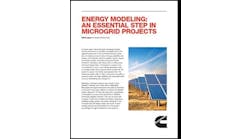Which type of microgrid controller can take advantage of the largest amount of renewable energy? Which type of microgrid controller can wring the most money per MWh out of the microgrid? Which best ensures resiliency?
Microgrid controllers can be optimized to focus on these and many other goals, but often can’t be optimized to meet all these goals at the same time, said Sarah Truitt, partnerships development manager for the National Renewable Energy Laboratory’s (NREL) Energy Systems Integration Facility.
In NREL’s Microgrid Controller Innovation Challenge, the organization seeks to answer these and other questions, using controllers from vendors who compete to take part in the challenge. Once manufacturers are chosen, their controllers will be run through a series of tests in NREL’s test bed, and the results will be used to help develop standards for microgrid controllers, said Truitt.
“We have a test bed where people can run experiments. The distribution circuit is modeled and simulated and there’s actually power hardware that the microgrid controller will control based on signals we send from the simulated grid,” she explained.
The challenge will give the top eight applicants the opportunity to test their controllers, modeling real-world grid scenarios at NREL’s Energy Systems Integration Facility in Golden, Col. The controllers will be evaluated based on how well they stabilize the grid under simulated events, such as grid outages.
The application period is expected to open in the spring, she said.
Investors lack information
“Controllers are very customized and difficult to scale to market. Early adopters and investors don’t have enough information about controllers. Standards aren’t yet developed; there is no way to say, ‘This is what a microgrid controller should do,'” Truitt said.
The microgrid controller challenge will focus on microgrids that operate both in grid and island mode.
“For example, the controller will respond to potential grid disturbances in grid mode. In island mode, it might respond to situations like generation failure and respond by dispatching additional generation of shedding load,” Truitt said.
The challenge will allow NREL to test different controllers from eight different vendors in an “apples to apples” environment and score them on how well they operate, she said. “We can share this information with the IEEE technical standards committee so we can help create appropriate standards for controllers.”
The idea is to create standards that will help utilities and others feel more comfortable adopting the technology, in the same way that UL listings help create confidence in products. The specific standards include IEEE 2030.7, which focuses on microgrid functionality, and IEEE 2030.8, which focus on ensuring controllers meet certain standards, Truitt said.
The standards would focus on issues such as voltage and frequency and how microgrids will operate when connected to a utility and how they should operate on their own, she said.
Inside the microgrid controller challenge
NREL’s test bed will include a 100-kW PV inverter, an electric vehicle, an 80-KW diesel generator set, a 250-AC Bus, and a real-time digital simulator, among other devices. “The controller will be operating these devices like it would be on the real grid,” said Truitt.
Up to eight contestants will be chosen to compete, and will have access to the lab facilities, engineering support for experiments, third-party technical evaluation and prizes.
Under the proposed schedule, the contestants will work in the labs the first week, then go home and have remote access to the test bed. Each contestant will have access to the lab on their own for a certain period of time. The competition runs from the end of June through early November.
NREL is conducting focus groups to gather feedback from the broader community about design. “We are asking, ‘What do you think is the basic core functionality in grid and island mode?'” said Truitt.
The Microgrid Controller Innovation Challenge is expected to be one in a series of challenges funded by the federal Department of Energy under a program called Lab-Bridge, which aims to facilitate the transfer of innovative technologies to the marketplace.
For more informaion on microgrid controllers, download the free Microgrid Knowledge whitepaper: “How Microgrids Can Achieve Maximum Return on Investment (ROI): The Role of the Advanced Microgrid Controller.”







